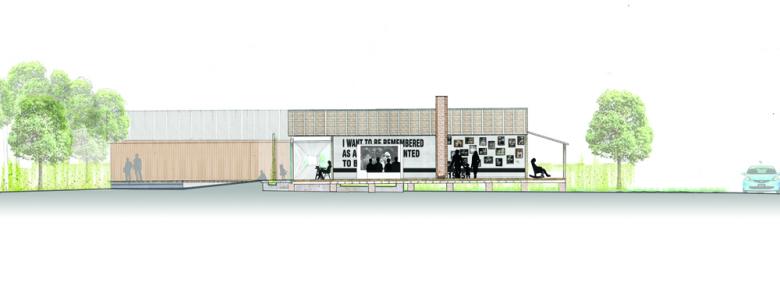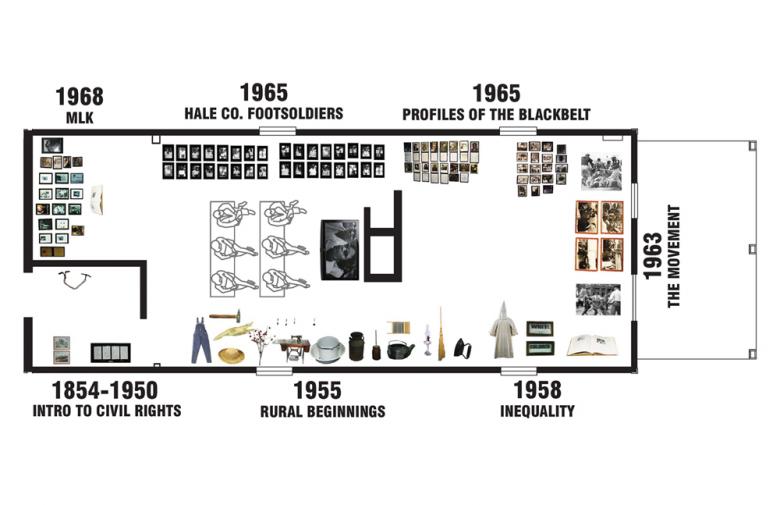Safe House Museum
Safe House Museum
7. January 2013
Auburn University's Rural Studio is one of the most respected undergraduate design-build programs, started by D.K. Ruth and Samuel Mockbee in 1993. Under current director Andrew Freear, the Rural Studio focuses on community-oriented projects in "West Alabama's Black Belt region," inluding Hale County, where the town of Greensboro and the Safe House Black Historic Museum are located. The 2010 thesis project restores the existing museum's two shotgun houses, adds gallery space, and links the two buildings together. The Rural Studio answered some questions about the project's design and construction.
View of entry courtyard
What were the circumstances of receiving the commission for this project?
Auburn University Rural Studio has been working in Hale County for the past 19 years and has developed close ties with community leaders. The Safe House Museum was an existing museum in the historic Depot neighborhood of Greensboro, AL. Over the years, Rural Studio had helped out with small repairs to the building, but was interested in helping the museum by fully renovating and expanding the existing structure. In 2010, Rural Studio assembled a three-person student team who worked with the Safe House Museum board to realize the renovation and expansion.
View of museum from street corner
Can you describe your design process for the building?
The original Safe House Museum consisted of two "shotgun" houses, one of which housed the original museum while the other home was used for storage. The houses are historically significant to the community, so the design team wanted to respect the houses while making expanding them and allowing them to function together as a museum. The original houses were respectfully restored to their original character. An expansion was added to the back of each building which mimicked the gabled shape of the houses. A glass walkway between the two expansions allowed the visitor to pass into both buildings. Great care was given to preserving the character of the original buildings while expanding the functionality of the museum.
View of museum interior, permanent collection
How does the completed building compare to the project as designed? Were there any dramatic changes between the two and/or lessons learned during construction?
As Rural Studio is a design-build program, the student team was able to have a direct access to the site and existing buildings throughout the design process. As such, the students were able to understand the implication of their design decisions. The final product is a direct response to the design process.
Rendered plan
How does the building compare to other projects at Rural Studio, be it the same or other building types?
The Safe House Museum project ties in with Rural Studio’s ethos of recycling, remaking and reusing existing materials and buildings.
Building section
Are there any new/upcoming projects at Rural Studio that this building’s design and construction has influenced?
We currently have a new student team designing a library for the town of Newbern using the town’s old bank building. The Safe House Museum has set a precedent for how to extrude an existing building and maintain the vernacular aesthetic of the building.
Exhibit layout plan
How would you describe the architecture of Alabama, and how does the building relate to it?
The original houses that comprise the Safe House Museum are pieced of vernacular architecture, representative of the South and the state of Alabama. There is much to learn from the structures that relied on passive systems instead of mechanical operations or advanced building materials. Such buildings respond to their climate and their forms are directly related to building performance. Alignment of windows for cross-ventilation, the use of piers to get the wooden structure away from the ground, pitched roofs to shed water, porches and overhangs used to cool air and filter sunlight – all of these things are responses to the local environment. The Safe House Museum project works to reinforce these principles in form and function.
Email interview conducted by John Hill.
Email interview conducted by John Hill.
View of entry courtyard
What were the circumstances of receiving the commission for this project?
Auburn University Rural Studio has been working in Hale County for the past 19 years and has developed close ties with community leaders. The Safe House Museum was an existing museum in the historic Depot neighborhood of Greensboro, AL. Over the years, Rural Studio had helped out with small repairs to the building, but was interested in helping the museum by fully renovating and expanding the existing structure. In 2010, Rural Studio assembled a three-person student team who worked with the Safe House Museum board to realize the renovation and expansion.
View of museum from street corner
Can you describe your design process for the building?
The original Safe House Museum consisted of two "shotgun" houses, one of which housed the original museum while the other home was used for storage. The houses are historically significant to the community, so the design team wanted to respect the houses while making expanding them and allowing them to function together as a museum. The original houses were respectfully restored to their original character. An expansion was added to the back of each building which mimicked the gabled shape of the houses. A glass walkway between the two expansions allowed the visitor to pass into both buildings. Great care was given to preserving the character of the original buildings while expanding the functionality of the museum.
View of museum interior
How does the completed building compare to the project as designed? Were there any dramatic changes between the two and/or lessons learned during construction?
As Rural Studio is a design-build program, the student team was able to have a direct access to the site and existing buildings throughout the design process. As such, the students were able to understand the implication of their design decisions. The final product is a direct response to the design process.
Safe House Museum
2011
Greensboro, AL
Architect
Auburn University Rural Studio
Newbern, AL
Student Team
Chris Currie, Cassandra Kellogg, Candace Rimes
Faculty & Staff
Andrew Freear, Rusty Smith, Johnny Parker, Dick Hudgens, Elena Barthel, Margaret Sledge, Steve Long, John Marusich, Danny Wicke, Mackenzie Stagg
Structural Engineer
GFGR Architects and Engineers
Environmental Design
Atelier Ten
Landscape Architect
Xavier Vendrell Architects
Exhibit Design
Bill Dooley and Andy Grace (University of Alabama)
Glass Consultant
Tim McFarlane
Letters and Window Decal
3M, installed by Sign Pro (Tuscaloosa, AL)
Salvaged Wood Floors
KMAC Greenworks (Birmingham, AL)
Wall Washer Lights and Baffles
Delray Lighting
Steel
Donated by Turnipseed International (Birmingham, AL)
Trees (Purple Plum, River Birch, Oak)
Williams Tree Farm (Wetumpka, AL)
Site Area
12,575sf
Building Area
2,475sf
Drawings
Auburn Rural Studio
Newbern, AL
Student Team
Chris Currie, Cassandra Kellogg, Candace Rimes
Faculty & Staff
Andrew Freear, Rusty Smith, Johnny Parker, Dick Hudgens, Elena Barthel, Margaret Sledge, Steve Long, John Marusich, Danny Wicke, Mackenzie Stagg
Structural Engineer
GFGR Architects and Engineers
Environmental Design
Atelier Ten
Landscape Architect
Xavier Vendrell Architects
Exhibit Design
Bill Dooley and Andy Grace (University of Alabama)
Glass Consultant
Tim McFarlane
Letters and Window Decal
3M, installed by Sign Pro (Tuscaloosa, AL)
Salvaged Wood Floors
KMAC Greenworks (Birmingham, AL)
Wall Washer Lights and Baffles
Delray Lighting
Steel
Donated by Turnipseed International (Birmingham, AL)
Trees (Purple Plum, River Birch, Oak)
Williams Tree Farm (Wetumpka, AL)
Site Area
12,575sf
Building Area
2,475sf
Drawings
Auburn Rural Studio








